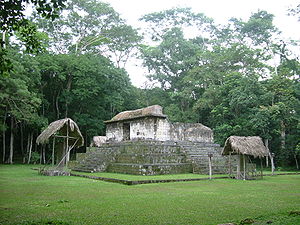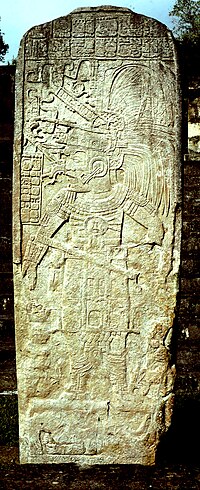Seibal
[4] Seibal experienced a significant recovery in the Terminal Classic immediately prior to its complete abandonment,[5] reaching its second peak from about 830 to 890, with a population estimated at 8–10,000 people.
[6] The dates on the stelae at Seibal are unusually late, with monuments still being dedicated after the Classic Maya collapse had engulfed most of the Petén region.
The early history of the site is lost due to the catastrophic defeat of the polity in AD 735 by the nearby Petexbatun kingdom with its capital at Dos Pilas, resulting in the destruction of its earlier sculpted monuments.
[33][34] Ceramics from the deep Middle Preclassic levels at Seibal belong to the little-known Real/Xe phase, found in the western Petén region.
[35] A cruciform Olmec-style cache consisting of a bloodletter and jade celts is similar to those found in the Olmec heartland on the Gulf Coast of Mexico, and the artifacts were probably manufactured at La Venta.
[40] During the Early Classic, the decline that began in the Late Preclassic continued unabated until the site was all but abandoned around AD 300 for unknown reasons.
[44] Any monuments raised by the Late Classic rulers responsible for this renewed occupation were defaced when the city suffered a catastrophic defeat in the 8th century AD.
[45] After the defeat of Seibal, foreign influences can be seen from Central Mexico in the art and stelae of the site dating to the Bayal phase (mid-700 CE-post-classic).
[51] Yich'aak B'alam continued as a vassal under the next king of Dos Pilas, K'awiil Chan K'inich, who presided over rituals at Seibal in 745 and 747.
[55] With its independence came a new apogee, and for a brief time Seibal became a prominent regional capital located on the important Pasión River trade route.
[57] Seventeen stelae carved between AD 849 and 889 show a mix of Maya and foreign styles, including a lord wearing the beaked mask of Ehecatl, the central Mexican wind god, with a Mexican-style speech scroll emerging from the mouth, carvings of foreign-style foot slippers, and squared cartouches.
[61] It is likely that they were attempting to reopen the old Pasión-Usumacinta trade route and were drawn to Seibal by its defensible location overlooking the Pasión River.
This stela is also the last dated monument raised at Seibal and by 900 the city was all but abandoned, the whole region had been engulfed by the Classic Maya collapse and trade no longer flowed along the Pasión-Usumacinta route.
This may reflect the loss of expertise in the Terminal Classic, with craftsmen less able to work monuments and large structures as time progressed.
He was having very little luck getting satisfactory material at Tikal due to lack of available water for the plaster casting at which point he traveled to Saxtanquiqui with Gorgonio Lopez Toledo, a former assistant to Alfred Maudley.
He took molds from some of the stelae and the resulting casts were displayed in the Exposition, bringing the recent discovery of the ruins to the attention of archaeologists for the first time.
[85] Monuments dating to the period when Seibal was a vassal of Dos Pilas (AD 735–761) are situated in the Central Plaza of the group.
The radial temple form was ancient in the Maya region, dating back to the Late Preclassic, but Wat'ul Chatel placed upon it a square shrine with four doors, one opening onto each of the stairways.
It is a range structure running north–south and once had a hieroglyphic stairway detailing Seibal's defeat by Dos Pilas, although the inscriptions have now been removed to the old project camp.
Fragments of stucco were also recovered, they once made up a colourful frieze above the front of the building that included modelled human figures.
The structure was built of finely cut limestone blocks and the walls were coated with stucco painted orange and turquoise.
It is believed that the building was part of a Terminal Classic royal palace with architectural features similar to those of the temple Structure A-3.
[104] Both ballcourts are aligned east–west, an unusual feature in the Maya area, although the topography of the site severely restricted the layout of the city to a principally east–west orientation.
[116] The stairway was installed by king Ucha'an K'in B'alam of Dos Pilas to record Seibal's status as a vassal after its defeat by that city.
[117] Stela 1, on the north side of the South Plaza near Structure A-3, names someone called "Knife-Wing", who is also known at distant Chichen Itza.
[120] Stela 3 bears a non-Maya calendrical date, one of the glyphs is cipactli, a crocodile head used to represent the first day of the 260-day calendar in central Mexico.
Schele and Mathews propose that the event depicted on this stela gave rise to the foundation legends of the K'iche' people.
[131] It depicts Wat'ul Chatel, dressed in Terminal Classic Maya style, although his foreign-looking face bears a moustache, which is not a typically Mayan characteristic.
The text on this stela displays the emblem glyphs of Tikal, Calakmul and Motul de San José, describing how he received visitors from those cities.
[134] Stela 11 is on the east side of Structure A-3 and describes the refounding of Seibal on 14 March 830 and the installation of its new lord, Wat'ul Chatel, as a vassal of Chan Ek' Hopet of Ucanal.





